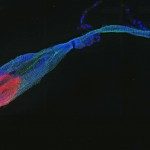Link to Pubmed [PMID] – 8649784
Oncogene 1996 Jun;12(11):2425-35
Activation of transcription factor NF-kappaB involves signal-induced degradation of the protein inhibitor IkappaB-alpha and release of NF-kappaB which translocates to the nucleus where it influences transcription of responsive genes. Although multiple regions of IkappaB-alpha are involved in this process, the N-terminal region of the protein has been identified as a regulatory region that is required for signal induced phosphorylation and degradation. The sensitivity of IkappaB-alpha degradation to peptide aldehydes which inhibit components of the proteasome and the detection of ubiquitinated forms of IkappaB-alpha indicate that IkappaB-alpha is degraded by the ubiquitin-proteasome pathway. To identify lysine residues that represent the sites of ubiquitin addition, a series of lysine to arginine mutations were introduced into IkappaB-alpha and the mutant proteins tested for their ability to function in vivo. Exposure of COS7 cells, cotransfected with IkappaB-alpha and a TNF-responsive NF-kappaB reporter gene, resulted in stimulation of reporter activity as a consequence of IkappaB-alpha degradation. In contrast, this effect was drastically reduced when an IkappaKB-alpha mutant carrying serine to alanine changes at amino-acids, 32 and 36, which blocks both signal-induced phosphorylation and ubiquitin conjugation of the protein, was co-transfected with the reporter gene. Likewise, a mutant form of IkappaB-alpha containing lysine to arginine changes at positions 21 and 22 (K21R, K22R) severely reduces TNF-induced activation of the NF-kappaB-dependent reporter gene. Examination of the metabolism of mutant IkappaB-alpha molecules reveals that, while the K21R, K22R mutant inhibits the DNA-binding activity of NF-kappaB and undergoes signal induced phosphorylation, it is neither ubiquitinated nor degraded in response to TNF. Thus, it is likely that after signal-induced phosphorylation Of IkappaB-alpha on serine residues 32 and 36, lysine residues 21 and 22 are major sites of ubiquitin ligation which target the protein for rapid degradation by the proteasome.

